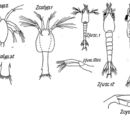Biology
provided by Arctic Ocean Biodiversity 2011
A common krill of the subarctic Atlantic and Pacific, and adjacent Arctic seas
- license
- cc-by-nc
- copyright
- Arctic Ocean Diversity
- author
- Alexei Pinchuk
- author
- Russ Hopcroft
Habitat
provided by Arctic Ocean Biodiversity 2011
Subarctic in deeper coastal waters and shelf breaks; Common in Arctic waters near Pacific or Atlantic inflows, uncommon in central basins; Undergo diel vertical migrations, spending daytime near bottom or to maxiamum of ~500 m, night-time in surface waters
- license
- cc-by-nc
- copyright
- Arctic Ocean Diversity
- author
- Alexei Pinchuk
- author
- Russ Hopcroft
Trophic Strategy
provided by Arctic Ocean Biodiversity 2011
Primarily herbivourous, may feed on detritous when food scarse; During open-water periods feed on phytoplankton when abundant (shifting to small zooplankton when phyoplankton less abundant); An important prey item for fish, birds, seals and whales
- license
- cc-by-nc
- copyright
- Arctic Ocean Diversity
- author
- Alexei Pinchuk
- author
- Russ Hopcroft
Comprehensive Description
provided by Arctic Ocean Biodiversity 2011
Transparent, yellowish if rich in lipids, females might develop blue hue when spawning; Eyes round, rostrum pointed, photophores red; Anntennae lack lappet, carapace without denticle; well-developed spine on 6th abdominal segment
- license
- cc-by-nc
- copyright
- Arctic Ocean Diversity
- author
- Alexei Pinchuk
- author
- Russ Hopcroft
Life Cycle
provided by Arctic Ocean Biodiversity 2011
Females lay several clutches of eggs (140 per brood on average) during spring; Females require repeated mating after each molt to form new egg clutches; Life cycles is typcial: eggs, nauplius, metanauplius, followed by several stages of feeding calytopsis, and furcillia larvae; Juveniles resemble adults, and molt regularly while growing to adulthood over the first year of life; Life expectancy not known, likely 1-2 years
- license
- cc-by-nc
- copyright
- Arctic Ocean Diversity
- author
- Alexei Pinchuk
- author
- Russ Hopcroft
Diagnostic Description
provided by iArczoo
Differs from other Thysanoessa species by the presence of a dorsal spine on the last segment of the abdomen.
- compiler
- Ershova, Elizaveta
Distribution
provided by iArczoo
Amphiboreal species; found in the Barents Sea, White Sea, Kara Sea, Bering Sea, Sea of Okhotsk.
- compiler
- Ershova, Elizaveta
Morphology
provided by iArczoo
The last segment of the abdomen carries a dorsal spine. The front edge of the carapace is transformed into an elongate rostrum. Uropods are shorter than the telson.
- compiler
- Ershova, Elizaveta
Size
provided by iArczoo
- compiler
- Ershova, Elizaveta
Uses
provided by iArczoo
Important food source for herring.
- compiler
- Ershova, Elizaveta
Distribution
provided by World Register of Marine Species
Arctic to Gulf of Maine
North-West Atlantic Ocean species (NWARMS)
- license
- cc-by-4.0
- copyright
- WoRMS Editorial Board
Habitat
provided by World Register of Marine Species
upper and glacial epipelagic regions of the Gulf and estuary, and the upper Mesopelagic of the Gulf and estuary
North-West Atlantic Ocean species (NWARMS)
- license
- cc-by-4.0
- copyright
- WoRMS Editorial Board
distribution
provided by World Register of Marine Species
depth in m: 200-300; horizontal distribution: amphiboreal species, N Pacific, N Atlantic
- Kylin, H. (1956). Die Gattungen der Rhodophyceen. C.W.K. Gleerup: Lund, Sweden. xv, 673 pp.
- Mauchline, J. and Fisher, L.R. (1969) The Biology of Euphausiids. Advances in Marine Biology 7: 1-454
- Brinton E (1962). The distribution of Pacific euphausiids. Bull. Scipps Inst. Oceanography, 8 (1): 51-269
- license
- cc-by-4.0
- copyright
- WoRMS Editorial Board

